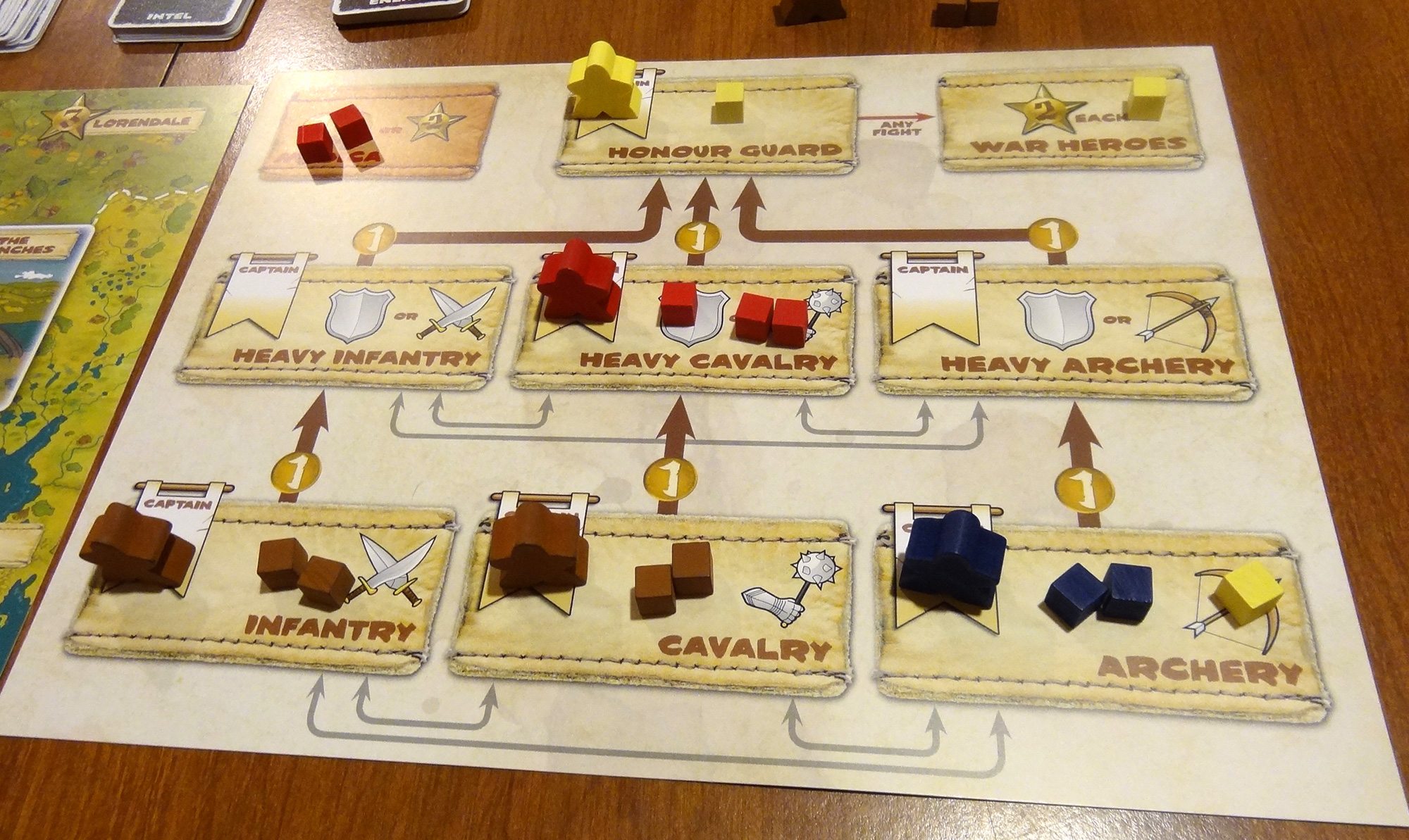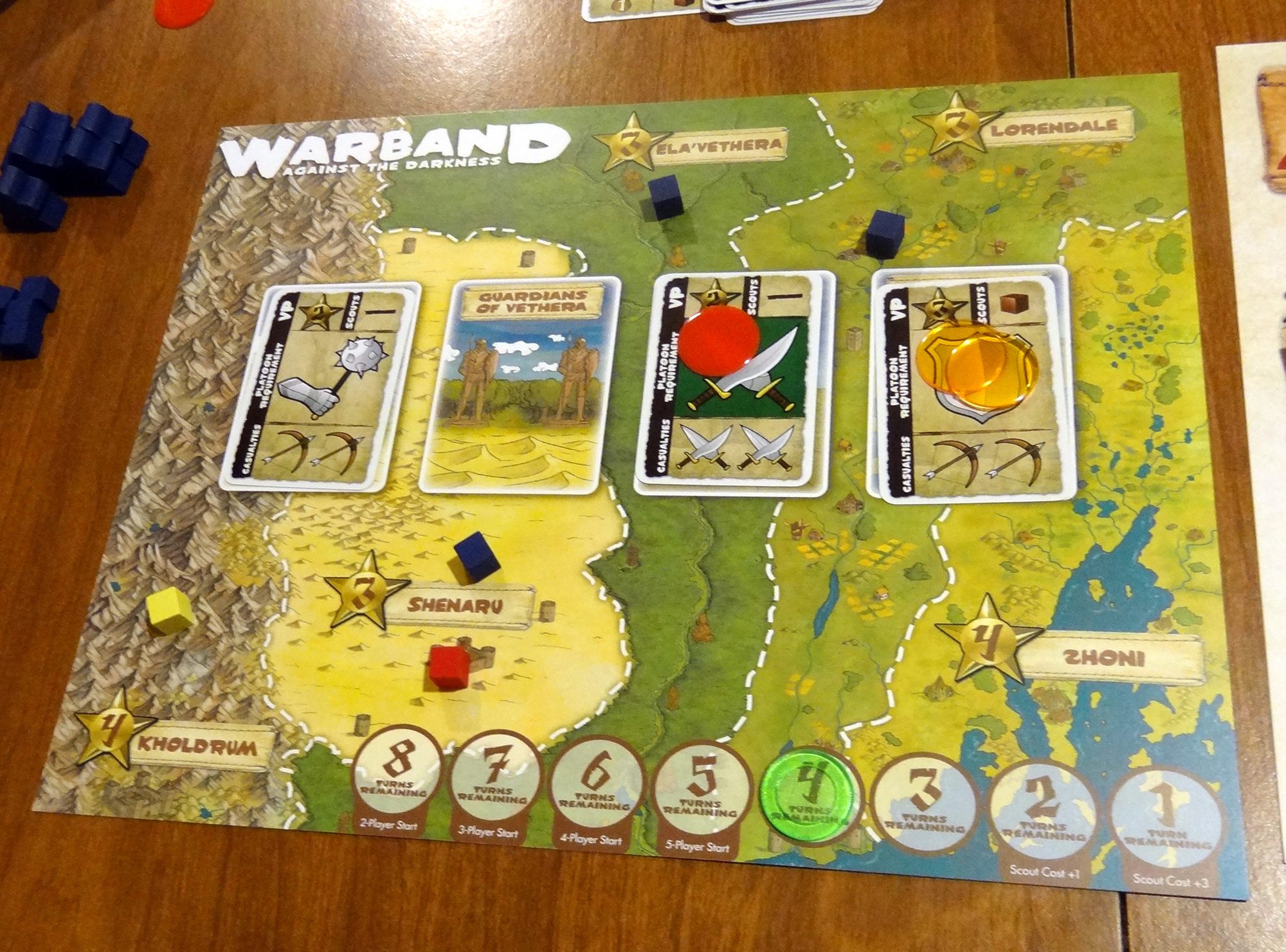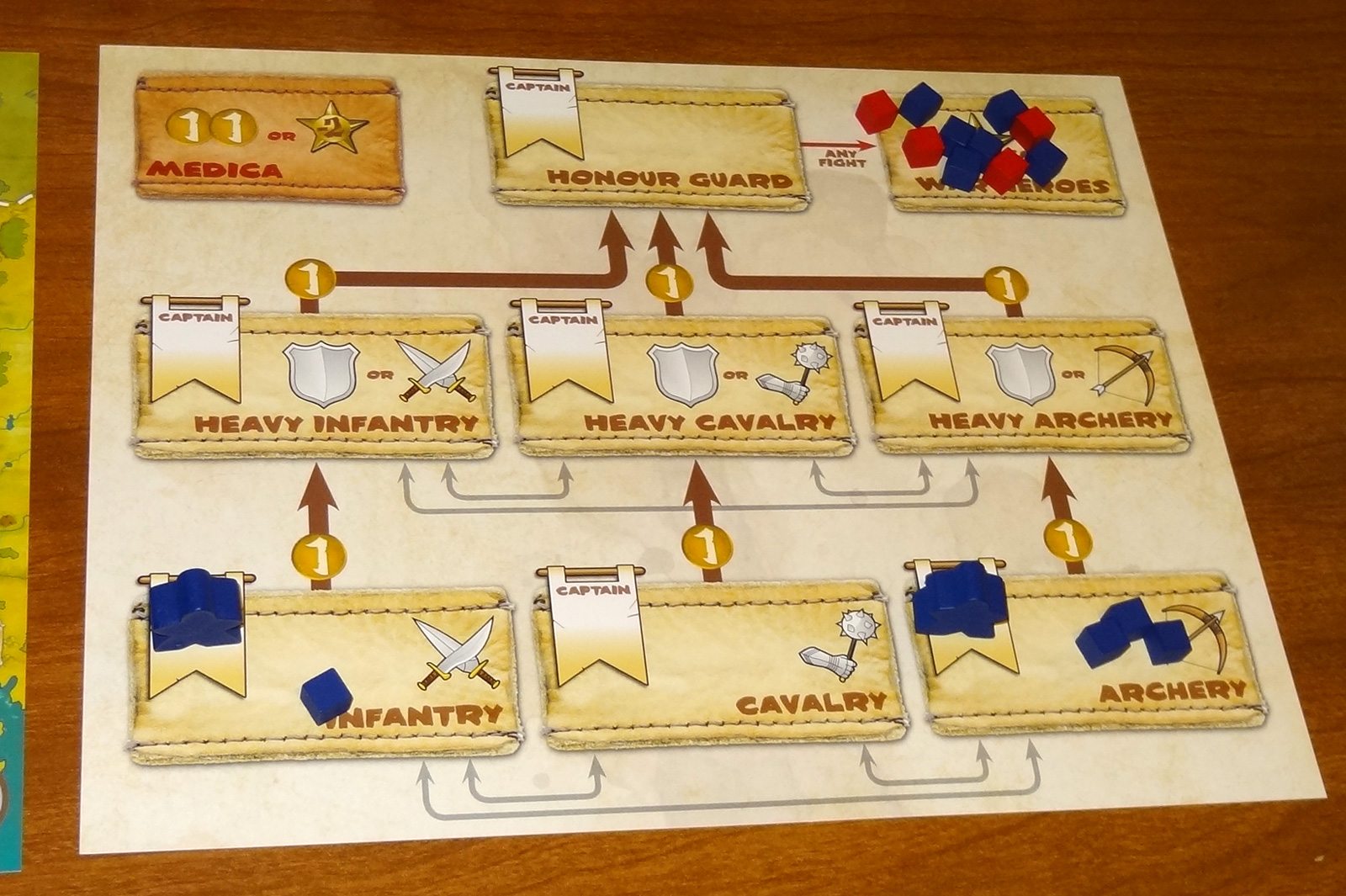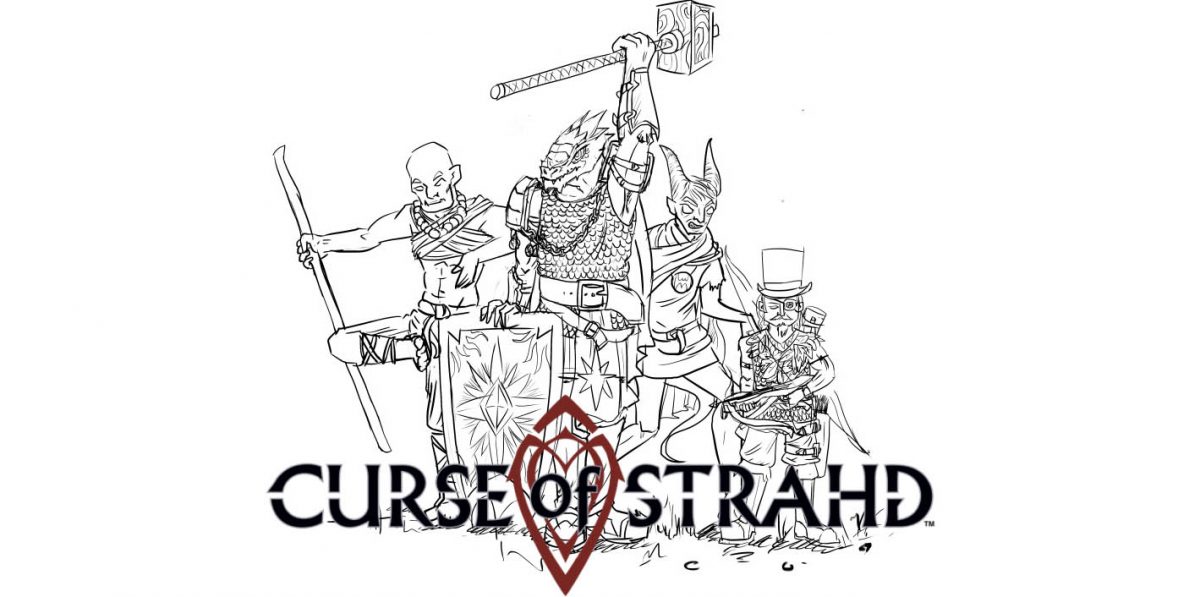
Let’s face it: we don’t like each other. But there’s this Big Bad to defeat, so we’re forced to share troops in this war. That doesn’t mean I’m gonna let you just boss me around, though—everyone knows my soldiers and scouts are the best, you just wait and see. Welcome to Warband: Against the Darkness.
At a glance: Warband: Against the Darkness is for 2 to 5 players, ages 10 and up, and takes 60-90 minutes per game. Dyskami Games is currently seeking funding on Kickstarter to produce the game, and the basic pledge level for a copy of the game is $49. Based on the complexity of the game, I think 10 and up is a pretty good age recommendation; I’m not sure I would try it with players much younger than that.
Components
I picked up a prototype copy at Gen Con, so the final components will differ from what you see in the photos, but here’s the list of components according to the Kickstarter page:
- A two-part game board (24′ x 12′) – the Five Realms map and the warband roster
- 74 mini-Euro game cards (24 Enemy cards, 20 Intel cards, 30 Redress cards)
- 106 wooden unit cubes (20 of each color – black, blue, red, white, yellow – plus 6 brown mercenary units)
- 38 wooden captain meeples (7 of each color – black, blue, red, white, yellow – plus 3 brown mercenary captains)
- 10 player race boards
- 5 race action track boards
- 5 player aid boards
- Dozens of cardboard coins in 1, 3, and 5 gold denominations
- Pencil and score pad
The artwork for the various race boards is great. The map and the warband roster are nice, though I’d appreciate a few tweaks here and there to make the small cards more readable.

How to play
A draft of the rulebook is available in PDF form.
The goal of the game is to win the most glory for your race by the end of the game—through war heroes, defeating enemies, and carefully placed scouts.
First, to set up, everyone gets a player board and a race, which gives a special ability. Each player also gets 3 coins and all the meeples and cubes in their color. Twelve of the cubes are placed on the player board, covering up all of the actions from Tier 2 and higher. The rest of the cubes go to the side of your board as a reserve. Each player also gets one scout on the board—placement is determined by player order.
On the boards, the three starting enemy cards are placed on the three leftmost battleground spaces. Two brown mercenary cubes are placed in each of the light platoons, and the brown meeples are placed in the corresponding platoon captain spaces. Each deck of cards (Enemy, Redress, Intel) is shuffled separately and placed face-down.
On each turn, you’ll do two things: upgrade your action track, and then take exactly three actions.

Upgrading the action track is pretty easy: you just remove the leftmost cube from any of the four action tracks on your board, which then unlocks that tier’s action. The cube goes into your reserve. For instance, in the picture above, I’ve upgraded my “Tax” action once, which lets me take 3 coins instead of 2. I’ve also upgraded my “Fight” action once, which will lower the requirements for me to battle.
You take three actions—these can be repeated or different actions—from the choices below:
- Tax: take coins from the bank
- Train: move cubes on the warband roster
- Scout: add scouts to the map
- Fight: fight an enemy on the map
The Tax action is pretty simple—you just collect however much your highest unlocked tier says. Scout is pretty easy, too: you pay the amount shown in order to place a number of scouts on the map. Upgrading this ability lets you place more at a time, and for less money, but the scouts must be placed in different areas.

Train is how you get cubes from your reserves onto the warband roster, as well as moving them around on the roster. Upgrading your Train ability lets you move more cubes per action (or move one cube more times). With each move, you may place a cube from your reserve onto the lowest level of the roster (light infantry, light cavalry, or light archery), move cubes along the same level of the roster (from light infantry to light archery, for instance), or promote to a higher level at the cost of one coin.
Each platoon has a captain banner—if you have the most cubes in a platoon, you become captain, and mark it with your meeple. Captains get paid when there’s a fight, and the captain of the Honor Guard gets to select a soldier to promote to “War Hero” status.
Fighting gets a little more complicated—mostly because it’s a multi-step process, not because any individual step is that difficult. Here’s the process:
- Check warband strength
- Pay captains’ wages
- Defeat enemy
- Draw intel
- Send units to Medica
- Assign casualties
- Draw redress cards
- Salute war heroes
- Raid and pillage
- Draw new enemy

1. First, checking the warband strength: you need enough power in the total warband to match the strength of all three enemies currently on the map. Each one shows a type of soldier as well as a number of victory points—you’ll need that many of that type of soldier. Some show Heavy as a type, so you’ll just need that many Heavy soldiers of any type, but each cube can only count as Heavy or its soldier type, not both. Upgrading your Fight ability lets you reduce the required number of soldiers for a fight.
2. Next, you pay the captains. For each captain on the roster that does not belong to you, pay one coin to the appropriate player (or to the bank, in the case of Mercenaries). Upgrading your Fight ability lets you waive payment for some number of captains.
3. You pick an enemy to defeat, take its card from the board (and any money accumulated on it).
4. Then you draw two Intel cards, keep one and return the other to the bottom of the deck. Intel will pay off later, based on where your scouts are.
5. If the enemy card shows one or two cubes in the “Scout” area, you must move that many cubes from your reserves to the Medica on the roster. These will count against you in final scoring, or may be returned to reserve by paying two coins each. Each scout you had present adjacent to the defeated enemy may save one unit from going to the Medica.
6. Each enemy card also shows casualties at the bottom—two units of the same type. The captain of that platoon takes casualties first, though if that player has scouts adjacent to the battlefield then each scout can save one unit at the cost of 1 gold—and then another unit dies instead. Light platoons take damage first, and if there aren’t enough, then the damage spills over to heavy platoons.
7. If you do take any casualties, you get to draw a Redress card, which can be used for various abilities that benefit you and/or harm your opponents.
8. The captain of the Honor Guard may promote one unit to War Hero. (These are worth 2 points each at the end of the game.)
9. The two remaining enemy cards each get 1 gold from the bank.
10. A new enemy card is drawn and placed in the previously empty battlefield.
After each player in turn has upgraded their action track and taken three actions, the round marker is moved. When a certain number of rounds has passed (based on the number of players), then the game is over—the Darkness is defeated, and it’s time to figure out which race achieved the most glory during the battle.
Enemy cards are worth 2, 3, or 4 points each. Each war hero is worth 2 points, and each unit in the Medica subtracts two points. Each platoon captain is also worth 1 point. The player with the most scouts in each region earns the points listed on the map (4 for the two end regions, and 3 for the others). Then, you compare your Intel cards to your scouts: for each region, you multiply the number of scouts you have there by the number of Intel cards for that region (to a maximum of 12 points per region). Finally, each scout you have on the map lets you convert 3 coins into 1 point.
The player with the highest score wins.

The Verdict
I’ve played a couple games of Warband, and I really enjoy it. I wasn’t sure what to make of it when I first saw it: the cover art made me think it was going to be a huge battle game with crazy abilities and probably lots of dice, but it’s actually a very clever Euro-style game with interesting choices to make on every turn. And while there is luck involved, a lot of the game is about making moves based on the current state of the board.
The downside to this is that it often feels more like a game of economics than battle—though, to be fair, war is often about economics. But this is a war that’s won or lost by the pencil-pushers, not the grunts on the front lines. It does lead to some interesting social commentary, though: The Honor Guard is the least likely to take casualties (and doesn’t contribute to the strength of the warband), but they’re the ones who get promoted as war heroes. Meanwhile, the units at the bottom of the ladder are the ones getting killed off. Hmmm.
My favorite part of the game is the action track: it’s like a little tech tree, and you get to decide what you’re going to upgrade. The delicious agony is that you want to upgrade everything, but you won’t get to. You only get so many turns, and each turn you only upgrade one thing. Much of the game depends on choosing the right track to upgrade, based on the current state of the war—and your ability.
The abilities of the various races are well-designed, and they do lend themselves toward particular tactics. The Elves can send scouts more cheaply, so it’s to their advantage to go for scouts. The Elementals never send units to the Medica, so then you’d want to attack higher-point enemies more often, without worrying as much about the location of your scouts. Maximizing the use of your ability can be quite important.
So far I’ve played with two and three players, and the game scales pretty well. I think it will be nice with up to five, though it does mean more downtime between turns. However, because other players’ actions affect you—getting paid as a captain, taking casualties and redress cards when other people fight—at least you do take interest during the other turns. With more players, you play fewer rounds, so the overall game time balances out.
Based on the description of the premise, I thought there would be some sort of “everybody loses” scenario, where the players didn’t cooperate enough to defeat the Darkness. It can feel a little anticlimactic, thematically, when you reach the end of the track and the game just ends. The gameplay is solid, though—but I think the theme does lend itself to that expectation. I haven’t tried it yet, but I’m considering a house rule where you must defeat a minimum number of enemies in order to win.
Certainly this is a game that can drag on if your gamers are prone to analysis paralysis, but I could also see it being a very quick game for players that make speedy decisions. In fact, other than the Fight action, all of the actions are very quick to carry out. Often, there won’t be enough strength in the warband to fight, so a round or two might zoom by before somebody is able to take the Fight action—and even then only if there’s enough money to pay the captains.
I also had a few quibbles here and there with the graphic design of the game—some of the numbers were hard to read across the table, and calculating the necessary strength of the warband wasn’t immediately intuitive—but they were mostly issues that arose during my first play, and were easily remembered on subsequent plays. (The layout and artwork are pretty much done, but some things may be tweaked a little before final production.)
One of the great things about Warband is that there really are multiple paths to victory. There are many ways to get points: defeating enemies, promoting war heroes, having the most scouts in a territory, having scouts in the right territories, building up a war chest that you can cash in. The first time I played, it was an extremely close game even though all three of us took different approaches. Many games claim there are multiple paths to victory, but Warband actually pulls it off.
Overall, I like Warband: Against the Darkness and I hope its Kickstarter campaign succeeds. It’s a nicely designed Eurogame with a lot of tough decisions throughout that have meaningful consequences. It’s not for players looking for a flashy battle with miniatures and dice, but more for those who want to geek out about the logistics (and, sometimes, the inequities) of war.
To back the project, visit the Kickstarter page.
Disclosure: GeekDad received a prototype demo of this game for review.




